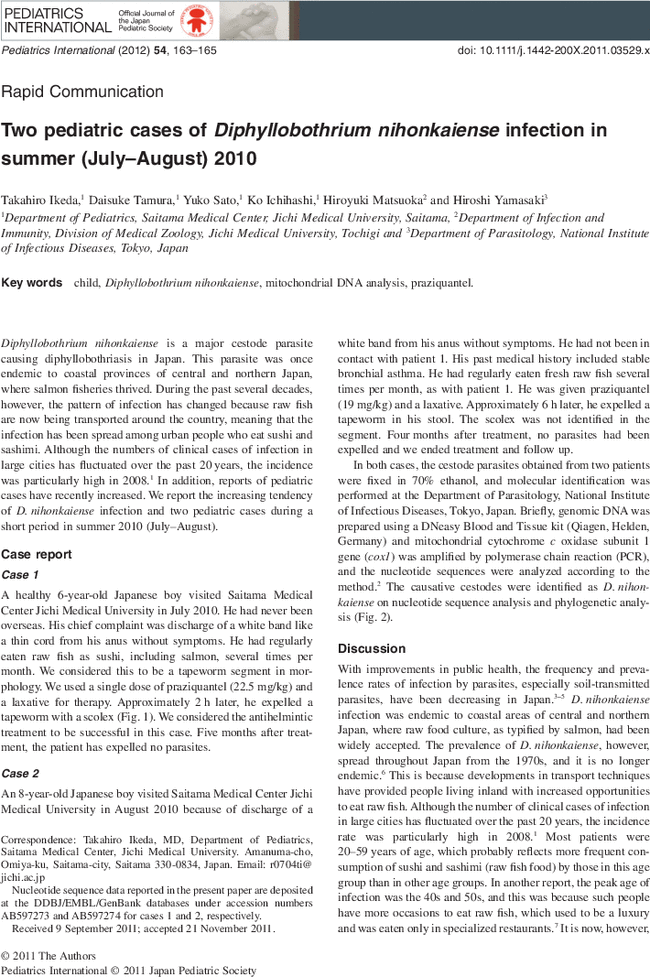Two pediatric cases of Diphyllobothrium nihonkaiense infection in summer (July–August) 2010
Corresponding Author
Takahiro Ikeda
Department of Pediatrics, Saitama Medical Center, Jichi Medical University, Saitama
Takahiro Ikeda, MD, Department of Pediatrics, Saitama Medical Center, Jichi Medical University. Amanuma-cho, Omiya-ku, Saitama-city, Saitama 330-0834, Japan. Email: [email protected]Search for more papers by this authorDaisuke Tamura
Department of Pediatrics, Saitama Medical Center, Jichi Medical University, Saitama
Search for more papers by this authorYuko Sato
Department of Pediatrics, Saitama Medical Center, Jichi Medical University, Saitama
Search for more papers by this authorKo Ichihashi
Department of Pediatrics, Saitama Medical Center, Jichi Medical University, Saitama
Search for more papers by this authorHiroyuki Matsuoka
Department of Infection and Immunity, Division of Medical Zoology, Jichi Medical University, Tochigi
Search for more papers by this authorHiroshi Yamasaki
Department of Parasitology, National Institute of Infectious Diseases, Tokyo, Japan
Search for more papers by this authorCorresponding Author
Takahiro Ikeda
Department of Pediatrics, Saitama Medical Center, Jichi Medical University, Saitama
Takahiro Ikeda, MD, Department of Pediatrics, Saitama Medical Center, Jichi Medical University. Amanuma-cho, Omiya-ku, Saitama-city, Saitama 330-0834, Japan. Email: [email protected]Search for more papers by this authorDaisuke Tamura
Department of Pediatrics, Saitama Medical Center, Jichi Medical University, Saitama
Search for more papers by this authorYuko Sato
Department of Pediatrics, Saitama Medical Center, Jichi Medical University, Saitama
Search for more papers by this authorKo Ichihashi
Department of Pediatrics, Saitama Medical Center, Jichi Medical University, Saitama
Search for more papers by this authorHiroyuki Matsuoka
Department of Infection and Immunity, Division of Medical Zoology, Jichi Medical University, Tochigi
Search for more papers by this authorHiroshi Yamasaki
Department of Parasitology, National Institute of Infectious Diseases, Tokyo, Japan
Search for more papers by this authorNucleotide sequence data reported in the present paper are deposited at the DDBJ/EMBL/GenBank databases under accession numbers AB597273 and AB597274 for cases 1 and 2, respectively.

References
- 1 Arizono N, Yamada M, Nakamura F, Ohnishi K. Diphyllobothriasis associated with eating raw Pacific salmon. Emerg. Infect. Dis. 2009; 15: 866–70.
- 2 Yamasaki H, Kuramochi T. A case of Diphyllobothrium nihonkaiense infection possibly linked to salmon consumption in New Zealand. Parasitol. Res. 2009; 105: 583–6.
- 3 Sato Y. Recent state of parasitoses in Japan: Epidemiology for clinicians. J. Jpn. Med. Assoc. 2005; 48: 148–54.
- 4 Kasai T, Nakatani H, Takeuchi T, Crump A. Research and control of parasitic diseases in Japan: Current position and future perspectives. Trends Parasitol. 2007; 23: 230–35.
- 5 Matsuoka H, Yoshida S, Hirai M, Ishii A. Reports of parasitic diseases and entomological cases in the Department of Medical Zoology, Jichi Medical School: Accumulated cases from five years. Jpn J. Infect. Dis. 2001; 54: 148–50.
- 6 Kagei N. Diphyllobothriasis nihonkaiense and changes in population of patients in Japan. IASR Publishing Infectious Disease Surveillance Center. 1993 [Cited July 1993.] Available from URL: http://idsc.nih.go.jp/iasr/CD-ROM/records/14/16106 (in Japanese).
- 7 Matsuoka H. Analyses of diphyllobothriasis nihonkaiense cases consulted to Jichi Medical University for last 14 years. Clin. Parasitol. 2008; 19: 153–5 (in Japanese).
- 8 Yanagida T, Matsuoka H, Kanai T, Nakao M, Ito A. Anomalous segmentation of Diphyllobothrium nihonkaiense. Parasitol. Int. 2010; 59: 268–70.
- 9 Yéra H, Estran C, Delaunay P, Gari-Toussaint M, Dupouy-Camet J, Marty P. Putative Diphyllobothrium nihonkaiense acquired from a Pacific salmon (Oncorhynchus keta) eaten in France; genomic identification and case report. Parasitol. Int. 2006; 55: 45–9.
- 10 Wicht B, Marval F, Peduzzi R. Diphyllobothrium nihonkaiense (Yamane et al., 1986) in Switzerland: First molecular evidence and case reports. Parasitol. Int. 2007; 56: 195–9.
- 11 Shimizu H, Kawakatsu H, Shimizu T et al. Diphyllobothriasis nihonkaiense: Possibly acquired in Switzerland from imported Pacific salmon. Intern. Med. 2008; 47: 1359–62.
- 12 Suzuki J, Murata R, Yanagawa Y, Araki J. Identification of Diphyllobothrium nihonkaiense by PCR-based approach. Clin. Parasitol. 2006; 17: 22–4 (in Japanese).




